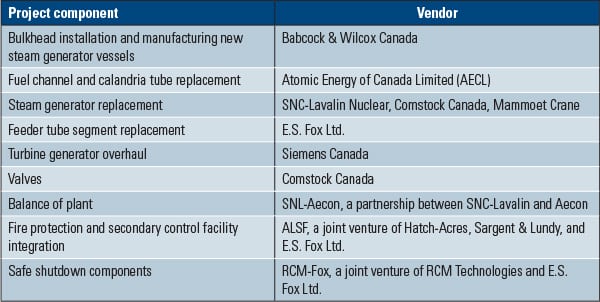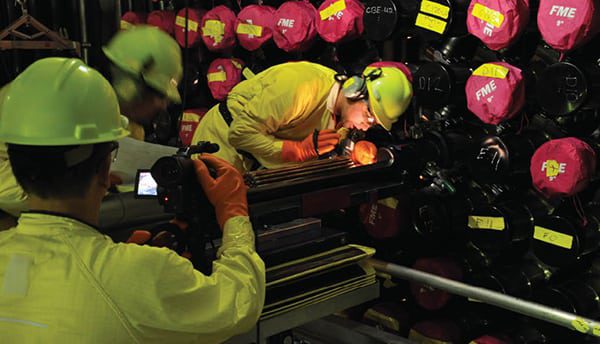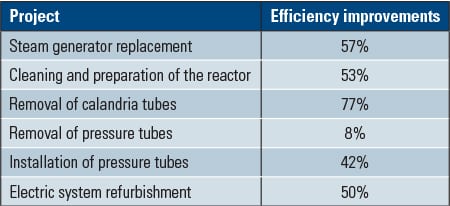Top Plant: Bruce Nuclear Generating Station, Kincardine, Ontario, Canada
Bringing four units back online and extending the life of four sister units has made the Bruce Nuclear Generating Station the largest operating nuclear plant in the world. The investments to bring the plant back to full power have also helped enable the province’s phase-out of all coal generation.
According to Duncan Hawthorne, president and CEO of Bruce Power, 2012 was one of the most successful years in the company’s history. The $7 billion investment to revitalize four dormant CANDU Bruce A units (1 through 4) while extending the operating life of the four Bruce B units (5 through 8) made it the largest operating nuclear power facility in the world. The current 6,300-MW capacity supplies one-quarter of Ontario’s electricity and provides enough replacement power for the province to achieve its goal of shuttering all coal-fired plants by 2014.
For successfully completing numerous first-of-a-kind engineering accomplishments through innovation, transforming its workforce through new hiring and training, and positioning the site for long-term stability to achieve the province’s environmental goals, Bruce Generating Station is recognized as a 2013 POWER Top Plant.
The Home Stretch: Units 1 and 2 Refurbishment
Bruce Power is a business partnership consisting of Cameco Corp., Trans-Canada Corp., BPC Generation Infrastructure Trust, the Power Workers Union, and the Society of Energy Professionals. When Bruce Power took over the plant site on Lake Huron in May 2001, only half of the eight CANDU reactors were generating electricity. After returning Units 3 and 4 to service in 2004 and 2003, respectively, the company pursued full refurbishment and recommissioning of Units 1 and 2 in October 2005—an effort that was ranked as one of the 100 biggest infrastructure projects in Canada. In the August 2010 issue, POWER reported on this ambitious restart project (“Bruce A Proves There Are Second Acts in Nuclear Power”), as both units had been out of service for over a decade and a half.
After Bruce A was laid up in the 1990s, fossil generation increased from 12% in 1995 to 29% in 2000. In the past 10 years, with the return of Bruce A units, coal use has dropped by 90% and will be phased out entirely next year. Consequently, since 2005, summer smog days in the Greater Toronto Area have fallen from 45 to 12. (For more on the province’s coal phase-out, see the May 2013 cover story, “Ontario Goes Coal-Free in a Decade.”)
The multibillion dollar project to restore Units 1 and 2 to service involved numerous contractors involved with the installation, replacement, or overhaul of several components (Table 1). Details on some of the projects and specific accomplishments follow.
 |
| Table 1. Contractors supporting the Bruce A refurbishment/restart project. Source: Bruce Power |
Fuel Channel and Calandria Tube Replacement. The “detube-retube” project for both units was deemed critical path and set the pace for the restart project. First-of-a-kind remote-controlled tooling was deployed to cut out the original components, which were radioactive from years of service. The new components were installed manually by workers inside the reactor vaults. These fuel channel assemblies, approximately 12 meters long from end-to-end, hold the reactor’s uranium fuel bundles during operation. Twelve bundles are inserted into each channel for a total of 5,760 bundles. Horizontal calandria tubes house the center section, the pressure tube portion of the fuel channel assembly. After much preparation, work to replace 480 fuel channel assemblies and 480 calandria tubes for both units was declared complete in April 2011.
Feeder Tube Segment Replacement. Corroded from years of use, the lower segments of the 960 feeder tubes in both units were removed early in the restart project. Feeder tubes connect the reactor’s fuel channel assemblies to the heat transport system, which circulates heavy water coolant from the reactor through the steam generators and back again. The first new feeder segment was installed in Unit 2 on Feb. 4, 2011. Work crews were challenged throughout the program by tight fit-up and stringent weld requirements, but by Oct. 14, 2011, feeder tube installation was complete in both Units 1 and 2. Final clearance adjustments were made in 2012 during commissioning of the heat transport systems.
Turbine Generator Inspection and Overhaul. Major turbine-generator work included maintenance, spindle blade replacement, and valve restoration, as well as installation of new governor and excitation systems. In addition, work on Unit 2 included the installation of a spare generator stator. The Unit 2 turbine generator was overhauled and ready for commissioning by mid-June 2010. New low-pressure spindles were installed in Unit 1 during the latter part of 2011 to prepare the unit for restart in 2012.
Valves, Maintenance, and Special Projects. Project management crews looked after the maintenance of equipment and valve restoration in both units for the duration of the project. In 2009, when it became evident that valve repairs were holding up other aspects of the project, a specific team was formed to take charge of all remaining valves on the project. In all, more than 3,600 valves were replaced or restored during the refurbishment.
Specialized work that went beyond normal maintenance was assigned to a Bruce Power special projects crew. This work was associated with adverse legacy conditions from years of operation, and it frequently involved high-hazard tasks. Some of the jobs included the removal and replacement of a broken shutdown rod guide tube, installation of new neutron flux detectors, fabrication and installation of new suspension floors over the reactivity decks, restoration of the south fueling trolley, and replacement or repair of thousands of pipe hangers throughout the units.
Return to Operations and Restart
Components and systems all had to be tested to verify performance and to demonstrate correct operations under normal and abnormal operating conditions. With heavy water in the reactor system, operators placed the Unit 2 reactor in an over-poisoned guaranteed shutdown state on June 28, 2011. The Canadian Nuclear Safety Commission (CNSC) granted permission to manually load fuel four days later. On Mar. 16, 2012, the CNSC granted permission to lift reactor shutdown guarantees and begin start-up. Criticality was achieved on Apr. 10 for the first time in 17 years. Unit 1 synchronized to the grid on Sept. 19, 2012, followed by Unit 2 on Oct. 16, 2012. Table 2 lists efficiency improvements during the project.
Don’t Forget About Units 3–8
Unit 3 originally returned to service in January 2004 after being laid up in 1998 by former operator Ontario Hydro. Seven years after its restart, the unit underwent a six-month “West Shift” outage, one of the most innovative programs in CANDU history. The $300 million investment allowed crews to adjust fuel channels after they had been lengthened by years of high temperatures, radiation, and pressure. The program is expected to extend the life of Unit 3 through the end of the decade.
Unit 4 has also performed well since returning to service in October 2003 after its 1998 layup. In 2012 it set a post-refurbishment long-run record of 570 days before going into a maintenance outage mid-year for additional life extension. That unit came back online in April 2013.
Additional improvements to Bruce B are also noteworthy. For example, through a process known as “core re-ordering,” which involves changing the direction in which fuel is inserted into the reactor, all Bruce B units have been increased from 90% to 93% reactor power. Combining all four Bruce B units, this resulted in a 100-MW increase in generation. Additionally, Unit 6 was the top performing CANDU reactor in the world at year’s end 2012 with a perfect 100 score on the World Association of Nuclear Operators’ Nuclear Performance Index. Units 5–8 ran so safely and reliably in 2012 that they finished the year with a capacity factor of 95% (factoring in surplus baseload generation and transmission constraints)—a significant jump from the 2011 capacity factor of 88.5%.
Preparing for the Future
One area of focus for Bruce Power is ensuring that knowledge from experienced employees is transferred to the next generation of nuclear workers. In 2001, when Bruce Power was formed, succession planning was not in place, and only 10% of employees were 35 or under and almost 50% were over 46. Since then, when 234 new people were hired in 2012, over 32% of employees were 35 and under, while an equal number were between 46 and 55.
By building on the experience gained over the past 10 years, renewing its nuclear infrastructure, and applying knowledge management to maintain a trained and qualified workforce, Bruce Power continues to invest in all eight CANDU units, while providing the province with a reliable baseload source of electricity. ■
—James Hylko is a POWER contributing editor.

